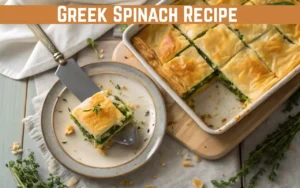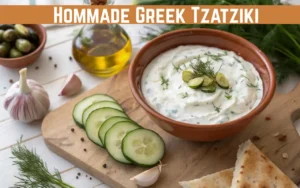Why Greek Cuisine Captivates the World
There’s a reason Greek food feels like a feast even when it’s simple. Fresh ingredients, big flavors, warm bread on the table, a glass of wine or raki to share Greek cooking is all about turning humble dishes into moments worth gathering for. Whether it’s a crisp Greek salad under the sun, slow-baked casseroles that fill the house with the smell of cinnamon and tomato, or trays of sticky sweets passed around at family celebrations, traditional Greek recipes tell a story that connects ancient traditions with today’s kitchens.
This guide is your starting point for bringing that story home. You’ll find time-tested dishes, regional specialties, modern twists for every diet, and practical tips to help you cook Greek food that’s real, fresh, and satisfying.
Table of Contents
A Brief History of Greek Cooking
Greek cuisine is deeply rooted in thousands of years of simple, seasonal eating shaped by the Mediterranean climate and rich cultural exchanges with neighboring lands. Olive oil, grains, wild greens, wine, honey, and fresh herbs have always formed the backbone of Greek meals—a connection to the land and the sea that carries through to today.
From the ancient banquets of the Classical era to the humble village kitchens of rural Greece, recipes have passed from generation to generation with little change. Many classic Greek recipes—from flatbreads to slow-baked meats and fresh cheeses—have roots in these age-old methods, blending local ingredients with flavors borrowed from the Ottomans, the Middle East, and beyond.
Today, traditional Greek recipes remain a living part of everyday life. They combine the wisdom of the past with the flexibility to adapt to modern tastes—all while celebrating what matters most: fresh food, family, and time at the table.
Essential Ingredients of the Greek Pantry
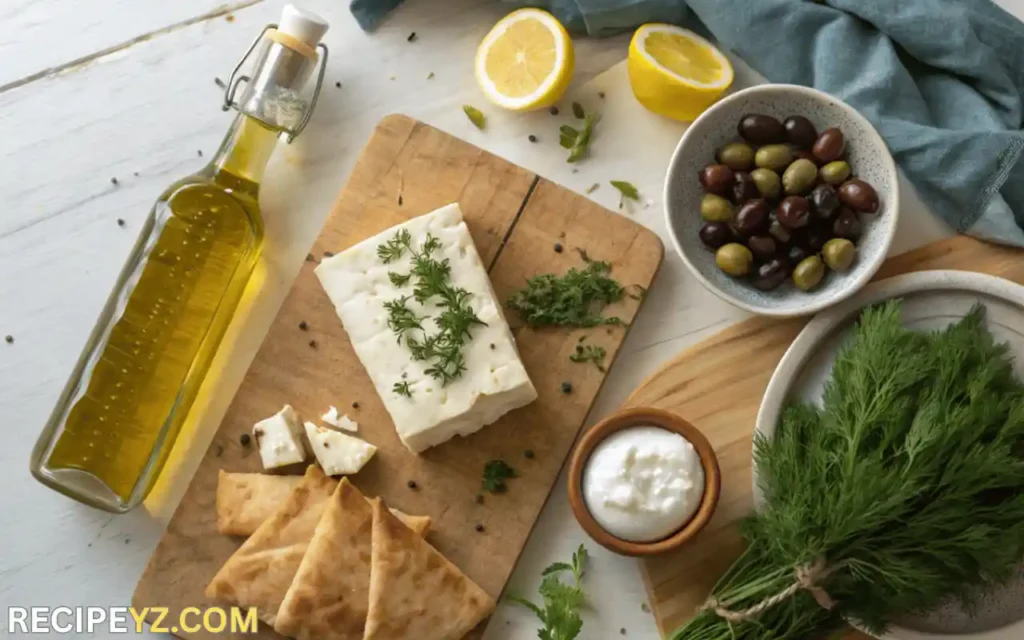
Before you cook your first Greek meal, stock your pantry like a Greek kitchen. The magic of Greek food is how a few fresh ingredients come together to create bold flavors without fuss.
Olive Oil: The heart of Greek cooking. Use good-quality extra virgin olive oil for salads, dips, marinades, and drizzling over just about everything.
Greek Yogurt: Thick, strained yogurt is the base for classic dips like Tzatziki (link to How to Make Authentic Greek Tzatziki) and also adds creaminess to marinades, baked goods, and desserts.
Herbs and Spices: Oregano, mint, dill, parsley, rosemary, cinnamon, and clove—simple seasonings that turn everyday dishes into unmistakably Greek meals.
Cheeses: Feta is the king of Greek cheeses. You’ll also find soft cheeses like mizithra in island recipes such as Dakos Salad (link to Cretan Dakos Salad).
Lemons and Citrus: Fresh lemon juice brightens marinades, stews, and desserts like the Gluten-Free Greek Lemon Cake.
Phyllo Dough: Thin sheets of unleavened pastry used in countless Greek recipes, from Spanakopita (link to Spanakopita: Greek Spinach Pie) to sweet treats like Baklava.
Olives and Olive Products: Kalamata olives and other local varieties are everyday staples—in salads, meze spreads, or served simply with bread and cheese.
When your pantry is stocked with these essentials, you’re ready to explore Greek starters, hearty mains, rustic regional recipes, and even modern twists.
Greek Cooking Tools and Kitchen Basics
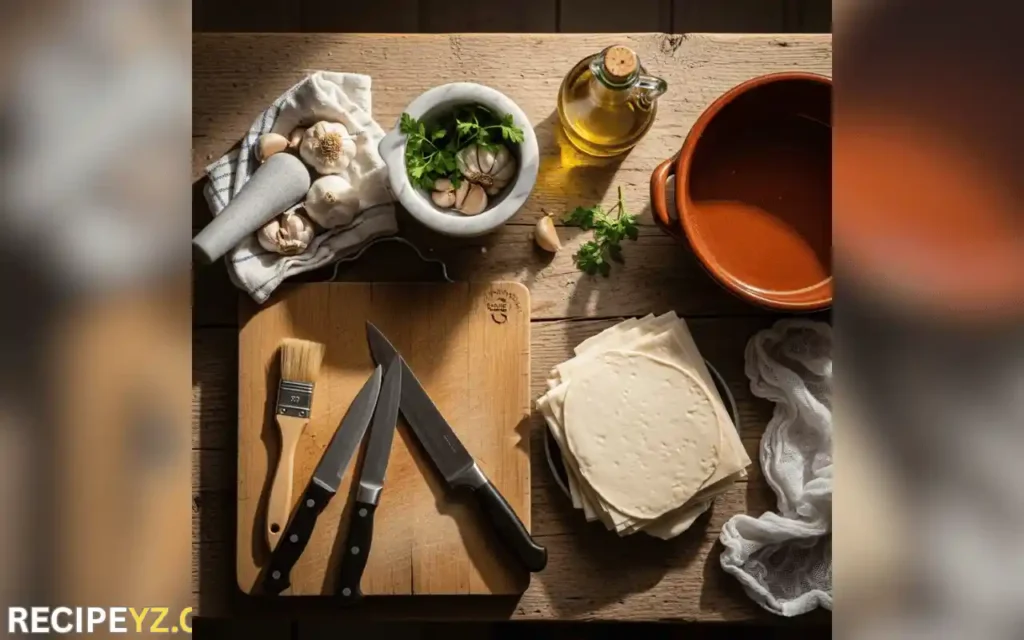
You don’t need a fancy kitchen to cook like a Greek—just a few good tools, a stocked pantry, and a willingness to keep things simple and fresh. Here are the everyday basics that help bring authentic Greek recipes to life.
Essential Tools for Everyday Greek Cooking
Essential Tools: Good Knives and a Large Cutting Board
Greek cooking is heavy on fresh herbs, vegetables, and small prep tasks like chopping greens for Spanakopita. A sharp chef’s knife and a sturdy cutting board will do half the work for you.
Mortar and Pestle
Many Greek cooks still crush garlic, herbs, and spices by hand to release their full flavor—especially when making classic dips like Tzatziki or herb marinades for Souvlaki.
Clay Pots and Casserole Dishes
Slow-baked dishes like Moussaka or stews benefit from clay pots or heavy ceramic casserole dishes that hold heat and moisture beautifully.
Pastry Brush and Phyllo Tools
Working with phyllo pastry for Baklava or Spanakopita calls for a soft pastry brush to spread melted butter or oil evenly between layers.
Cast Iron or Grill Pan
When grilling outdoors isn’t possible, a good cast iron skillet or stovetop grill pan is perfect for searing meats like Souvlaki or vegetables with those classic char marks.
Helpful Extras
Large Mixing Bowls and Baking Pans
Whether you’re tossing fresh salad greens or layering a rich casserole, having a few large bowls and reliable baking pans makes Greek meal prep smooth and simple.
Strainer and Cheesecloth
A simple cheesecloth and strainer are timeless Greek kitchen staples for draining yogurt when making thick Tzatziki or for prepping homemade cheese.
With these kitchen staples, you’ll be ready to tackle any recipe in this guide, from starters to desserts.
The Meze Tradition: Greek Starters and Small Plates
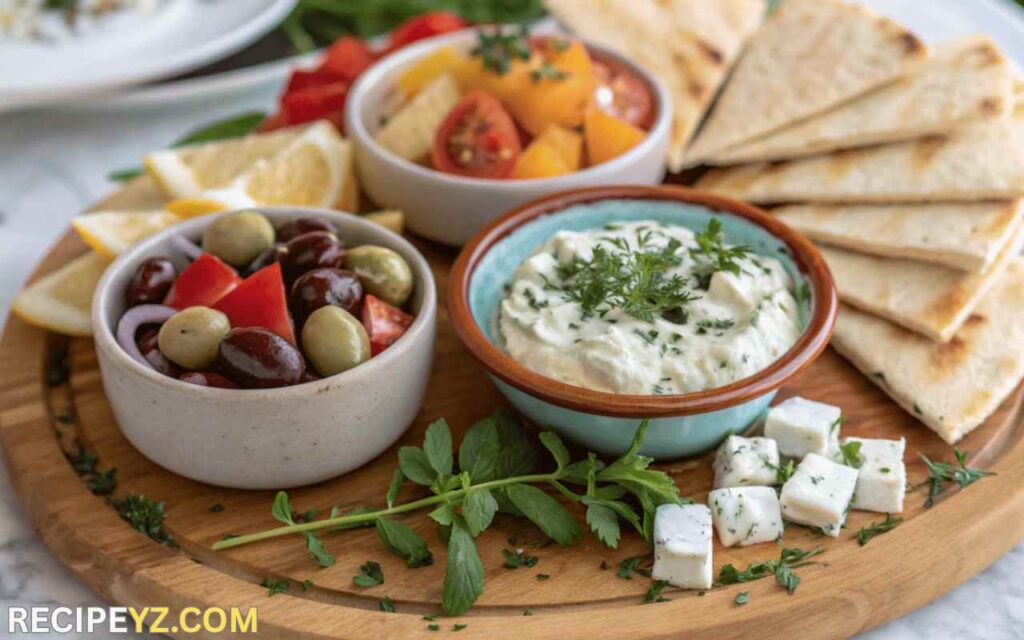
Greek meals don’t rush to the main course—they begin with meze: small, flavorful bites designed to bring people together over conversation and a glass of wine or ouzo. Whether served at a village taverna or a family table, meze sets the tone for a relaxed, generous meal.
What Is Meze?
Meze (or mezze) means “a taste.” It’s a collection of dips, breads, olives, cheeses, and savory pastries that can stand alone as a light meal or lead into heartier dishes. In Greece, meze isn’t just food—it’s a social ritual.
Classic Greek Starters
Some of Greece’s most beloved dishes are meze staples: cool, garlicky Tzatziki served with warm pita bread, smoky Melitzanosalata (eggplant dip), or crisp triangles of Spanakopita (spinach pie). Small plates keep coming, often alongside simple fresh vegetables, olives, and excellent bread.
How to Serve Meze at Home
Building a Greek meze spread is simple. Start with one or two fresh dips, a plate of warm Spanakopita or cheese pies, and bowls of olives and sliced vegetables. Arrange everything on rustic boards or small plates so everyone can reach, taste, and share.
Want to go deeper? Visit the full Greek Starters & Appetizers Cluster for ideas, recipes, and serving tips.
How to Make Authentic Greek Dips
Greek dips are the soul of any delicious meze spread—simple ingredients, bold flavors, and recipes passed down through generations. A bowl of creamy dip, a plate of warm pita, and a drizzle of olive oil can turn even the simplest gathering into a feast.
Tzatziki: Cool, Creamy, Essential
Tzatziki is Greece’s most famous dip—a refreshing blend of thick yogurt, grated cucumber, garlic, olive oil, and fresh herbs like dill or mint. Spoon it alongside grilled meats, serve it with vegetables, or pile it onto warm bread.
Learn step-by-step in How to Make Authentic Greek Tzatziki.
Melitzanosalata: Smoky Eggplant Spread
This rustic dip is made from roasted eggplant mashed with garlic, lemon juice, olive oil, and parsley. Its smoky flavor makes it perfect with bread or as a topping for grilled vegetables.
Other Favorites
Other Greek dips include Skordalia (a garlic and potato spread) and Taramosalata (a silky fish roe dip)—regional classics you’ll find in seaside tavernas and family tables alike.
Tip: Use the best olive oil you have—dips are simple but shine when each ingredient is high quality.
Hungry for more? Explore the full Greek Starters & Appetizers Cluster for more meze inspiration.
Greek Phyllo Pastries: From Spanakopita to Tiropita

Crispy, golden, and impossibly flaky—phyllo pastries are at the heart of Greek baking. From savory pies to sweet treats, delicate layers of paper-thin dough turn simple fillings into irresistible bites.
The Art of Working with Phyllo
Greek cooks use ultra-thin sheets brushed with butter or olive oil to make phyllo (or filo) pastry, which they then layer and bake until crisp. Greek cooks use phyllo for both savory pies and desserts, each with their family variations.
Spanakopita: Spinach Pie Perfection
One of Greece’s most famous pastries is Spanakopita — a savory spinach and feta pie wrapped in layers of phyllo. It’s served as a snack, appetizer, or light meal, and it’s beloved for its balance of earthy greens, creamy cheese, and crisp, buttery crust.
Tiropita and Other Savory Pies
Tiropita is a cheese pie made with feta or mizithra cheese and herbs, wrapped in phyllo and baked until golden. You’ll also find regional twists like hortopita (wild greens pie) or kreatopita (meat pie)—all variations on the same simple technique.
Tip: Keep your phyllo covered with a damp cloth as you work—it dries out quickly. Brush each layer well with butter or oil for the flakiest result.
Want to bake your own? Start with Spanakopita: Greek Spinach Pie Step-by-Step for an authentic, easy-to-follow version.
Traditional Greek Main Courses
Greek main dishes, hearty and comforting, are a staple of any family table, often prepared slowly with generous amounts of olive oil, herbs, and vibrant citrus flavors. These meals bring people together and showcase the simplicity and warmth of Greek village cooking.
Hearty Oven-Baked Classics
One of the best-known Greek mains is moussaka—a rich, layered casserole of roasted eggplant, spiced ground meat, and creamy béchamel sauce, baked until golden and bubbling. It’s a Sunday favorite, often served at big gatherings or holiday meals.
Rustic Stews and Bakes
Beyond Moussaka, Greek kitchens are famous for slow-cooked stews like stifado (a beef or rabbit stew with onions and red wine) or pastitsio, a Greek take on baked pasta with meat sauce and béchamel, similar to lasagna but uniquely seasoned.
Greek Grilling and Street Food
For something simpler and quicker, Greece’s street food tradition shines with souvlaki—small skewers of pork, chicken, or lamb marinated with olive oil, garlic, lemon, and oregano, then grilled to juicy perfection. Wrapped in warm pita with Tzatziki and fresh salad, Souvlaki is a taste of a summer night in a seaside town.
Craving more authentic mains? Dive into the Traditional Greek Main Courses Cluster to master these hearty recipes at home.
Famous Greek Comfort Dishes
Greek comfort food is built on recipes that feel timeless—passed down from grandparents, filling homes with warmth, and meant to feed a crowd. These dishes are simple but rich with flavor, built on excellent ingredients and patient cooking.
Moussaka: A Greek Icon
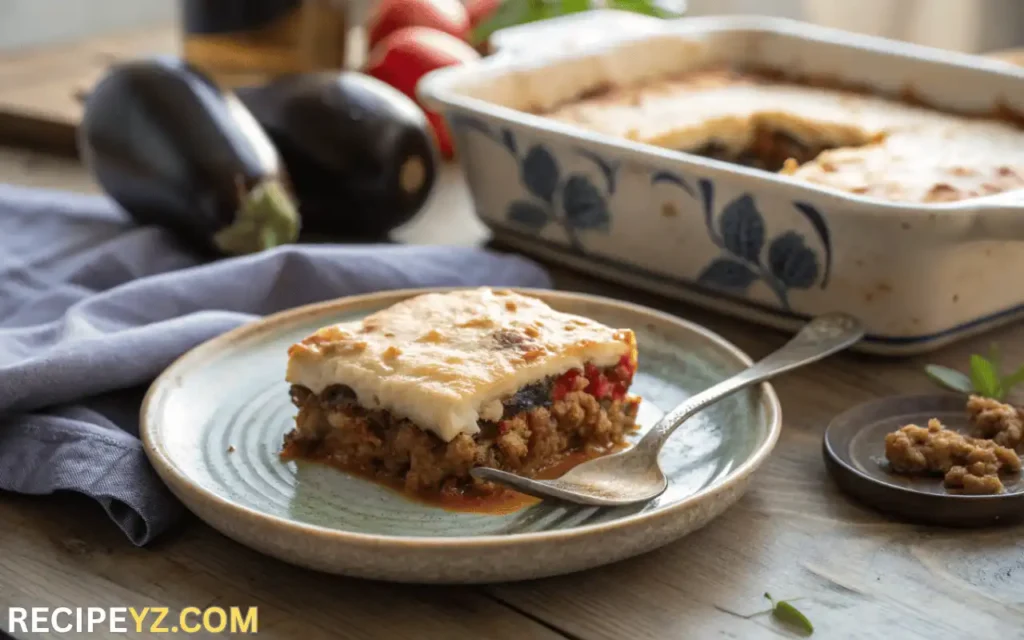
We can’t talk about comfort food without mentioning Moussaka again. Its layers of tender eggplant, savory meat sauce, and creamy béchamel make it one of Greece’s most recognizable and satisfying baked dishes.
Pastitsio: Greece’s Answer to Lasagna
Pastitsio is a baked pasta dish layered with long tubular pasta, ground meat spiced with cinnamon and nutmeg, and a thick layer of béchamel sauce. It’s the perfect family meal for holidays or Sunday dinners.
Stifado and Rustic Stews
Greek kitchens are famous for rustic one-pot stews like stifado—tender beef or rabbit slow-cooked with pearl onions, tomatoes, red wine, and warm spices. Served with crusty bread or over potatoes, it’s pure Greek village comfort.
These recipes remind us that Greek food is all about making humble ingredients shine—with warmth, patience, and a full table.
Hungry for more? See Traditional Greek Main Courses for full recipes and tips.
Greek Grilling and Street Food
Greek food isn’t just about hearty stews and baked casseroles—it’s also alive with street food culture and simple grilling traditions that make everyday meals feel like a summer feast.
Souvlaki: The Skewer That Feeds a Nation
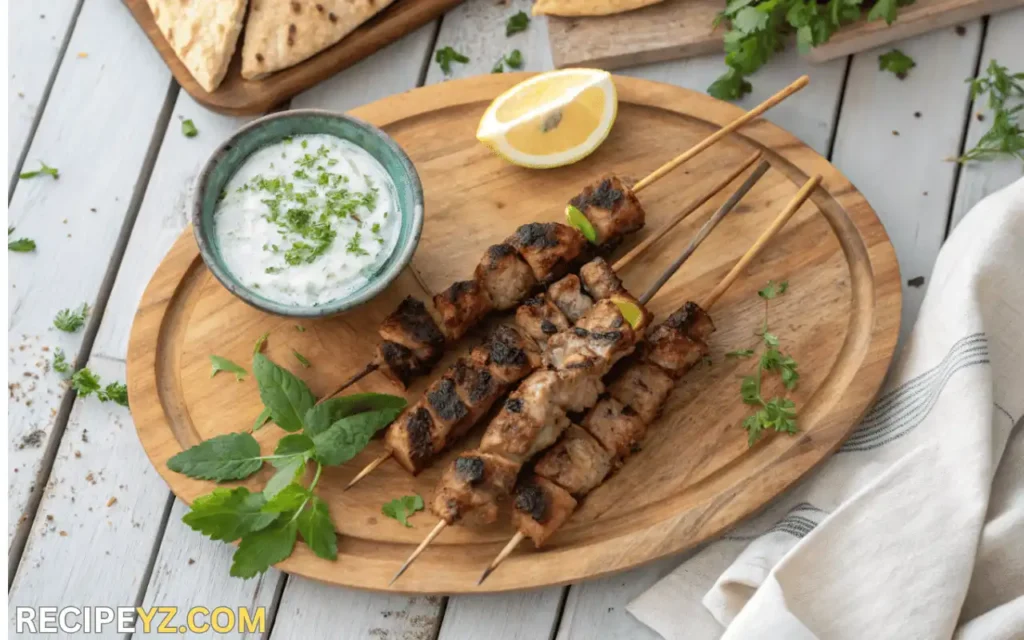
Greek Souvlaki is one of the country’s most beloved street foods. Bite-sized pieces of pork, chicken, or lamb are marinated in olive oil, lemon, garlic, and oregano, then grilled over an open flame until juicy and charred. Served in warm pita with Tzatziki, fresh tomato, onion, and sometimes fries, it’s a meal you’ll find everywhere—from city squares to seaside tavernas.
Gyros: Wrapped and Handheld
While Souvlaki is grilled fresh, gyros are made from layers of seasoned meat slowly roasted on a vertical spit. What’s the contemporary twist? Vegan Greek Gyros give you all the same bright flavors with marinated seitan or tofu instead of meat—a perfect example of how Greek street food adapts while staying true to its roots.
Backyard Greek Grilling
You don’t need a spit or a street cart to enjoy Greek grilling. A simple grill pan, a good marinade, and warm pita bread are enough to turn your kitchen or backyard into a Greek taverna.
Explore full grilling recipes in the Traditional Greek Main Courses Cluster and Modern & Healthy Greek Recipes for plant-based twists.
Fresh Greek Salads and Simple Sides
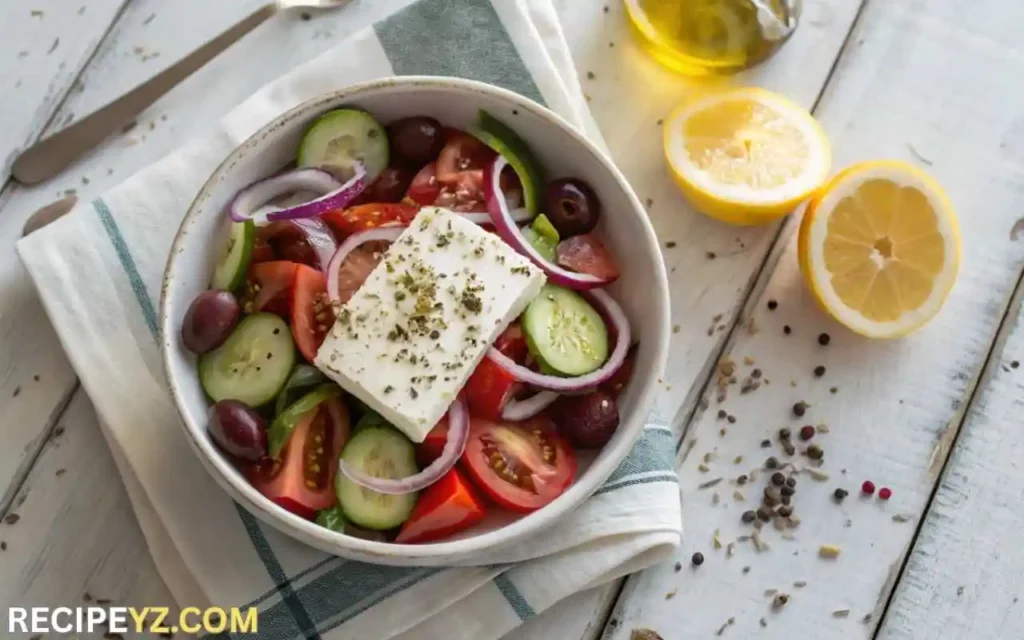
No Greek meal is complete without a bowl of fresh salad or simple sides that balance the richness of meats, pastries, and stews. Greek side dishes emphasize the prominence of seasonal ingredients.
The Classic Greek Salad
A traditional Horiatiki (village salad) is the star of the table: ripe tomatoes, crisp cucumber, green peppers, red onion, Kalamata olives, and a generous slab of feta drizzled with delicious olive oil and sprinkled with oregano. There is no lettuce, no fuss—just fresh vegetables and quality cheese. Expand your Greek culinary journey with these 30 must-try traditional Greek foods.
Simple Sides That Complete the Meal
Lemon-roasted potatoes are a classic Greek side: wedges of potato roasted with olive oil, garlic, oregano, and plenty of fresh lemon juice until golden and tender.
Other favorites include braised greens (horta), seasonal roasted vegetables, or slices of warm crusty bread to mop up sauces and dips.
Putting It All Together
Greek sides provide a balanced, light, and communal feel to the meal. Whether you’re serving Souvlaki, Moussaka, or a meze spread, fresh sides and salads tie everything together.
For regional twists, check out the Regional Greek Recipes Cluster—where local vegetables and herbs inspire countless simple side ideas.
Regional Greek Recipes: Local Flavors from North to South
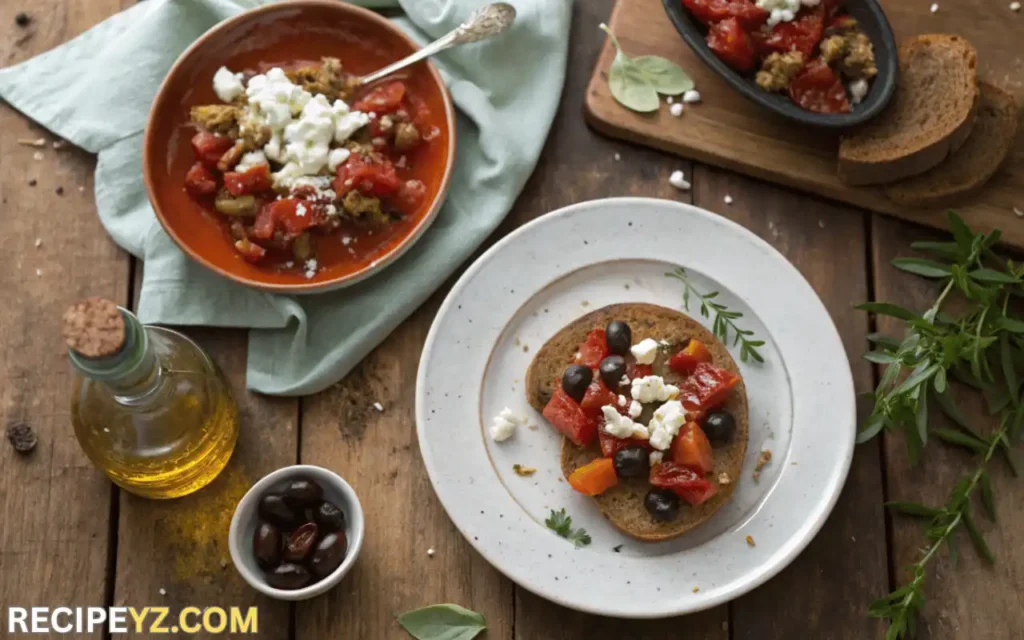
Greek cuisine isn’t just one tradition—it’s dozens of local specialties shaped by mountains, islands, villages, and old family kitchens. From the wild herbs of Crete to the hearty roasts of Macedonia, each region adds its personality to the Greek table.
Crete: Fresh, Rustic, and Olive Oil Rich
Cretan food is famous for its generous use of olive oil, barley rusks, simple cheeses like mizithra, and plenty of fresh vegetables. A perfect example is Dakos Salad—a rustic island bread salad topped with grated tomatoes, cheese, olives, and oregano.
Macedonia: Hearty and Homey
Northern Greek recipes lean into cooler climates and richer flavors—think stuffed vegetables like Macedonian Stuffed Peppers, meat stews, and roasted meats, all flavored with warm spices and fresh herbs.
Local Twists Across Greece
Visit any island or mainland village, and you’ll find old recipes that adapt classic ingredients in new ways: wild greens pies, local sausages, and fresh fish cooked over coals.
Want to explore more? Check the Regional Greek Recipes Cluster for full recipes and inspiration to bring local Greek flavors to your table.
Sweet Endings: Greek Desserts and Sweets
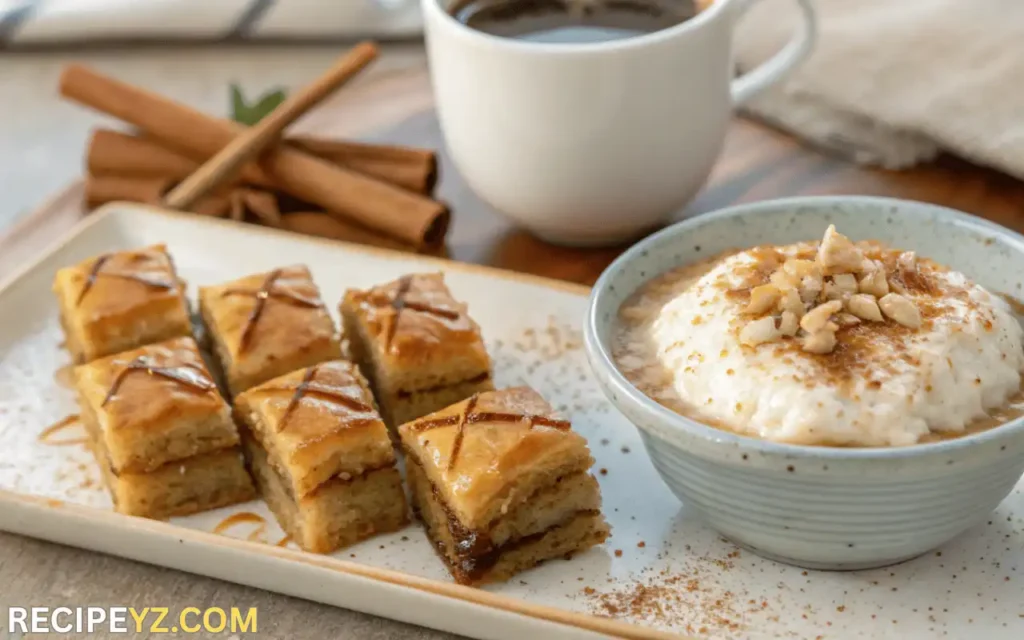
Greek meals often end on a sweet, sticky, and fragrant note—a small dessert with coffee or a plate of treats shared around the table. Greek sweets balance simple ingredients with satisfying textures and bold flavors.
Baklava: Layers of Crisp and Syrup
No Greek dessert list is complete without Baklava. Paper-thin sheets of phyllo are layered with nuts, warm spices, and drizzled with honey or sugar syrup until golden and sticky. It’s rich but served in small diamond-shaped pieces, perfect with strong Greek coffee.
Rizogalo: Creamy Comfort
Greek Rice Pudding (Rizogalo) is simple comfort food—short-grain rice simmered in milk until thick and creamy, lightly sweetened and topped with a sprinkle of cinnamon. Served warm or cold, it’s a nostalgic dessert found in village kitchens everywhere.
Festive Treats for Holidays
From Easter sweet breads to Christmas cookies like Melomakarona (honey-dipped spice cookies) or Kourabiedes (buttery almond shortbread dusted with powdered sugar), Greek desserts celebrate gatherings and family traditions.
Ready to bake something sweet? Explore the Greek Desserts & Sweets Cluster for recipes and step-by-step guides.
Modern & Healthy Greek Recipe Variations
Greek food has always been rooted in fresh vegetables, healthy fats, and simple, honest flavors—which makes it easy to adapt for modern tastes and dietary needs. Today, home cooks are giving old favorites a healthy twist while keeping true to the Mediterranean spirit.
Vegan Twists on Greek Favorites
Plant-based recipes are thriving in Greek cooking. Vegan Greek Gyros made with marinated seitan or tofu bring the same bold flavor as traditional gyros—wrapped in warm pita with fresh vegetables and dairy-free Tzatziki.
Gluten-Free Greek Baking
Greek baking adapts beautifully too. Classic cakes like the Gluten-Free Greek Lemon Cakehttps://www.recipeyz.com/modern-healthy-greek-recipes/ replace wheat flour with almond flour and gluten-free blends while staying moist, bright, and full of citrus.
Small Swaps for Healthier Greek Meals
Use Greek yogurt instead of cream for sauces and dips. Load up on fresh herbs and seasonal vegetables. Grill or bake instead of frying. These small changes keep Greek recipes light without losing flavor.
For ideas and recipes, dive into the Modern & Healthy Greek Recipe Variations Cluster for simple, satisfying ways to enjoy Greek food your way.
Hosting a Greek Feast at Home
Sharing is the essence of Greek food. A proper Greek meal isn’t rushed—it’s built around laughter, conversation, and plenty of plates passed around the table. Hosting your own Greek dinner doesn’t need to be complicated—just focus on good food, simple flavors, and a welcoming table.
Plan a Balanced Menu
Mix and match small plates and hearty mains. Start with meze: Tzatziki, Spanakopita, olives, and warm pita bread. Add a main dish like Moussaka or Souvlaki with a fresh salad and roasted potatoes. End with a sweet bite like Baklava or Rizogalo.
Set the Mood
Use simple plates, a jug of wine, and maybe a bottle of ouzo or raki for a true Greek touch. Add fresh herbs or lemons as table decor—the focus is on warmth, not formality.
Make It Easy
Many Greek recipes can be prepped ahead. Bake pies like Spanakopita in advance, marinate meats the day before, and keep dips ready in the fridge.
Keep It Relaxed
Let guests help themselves and linger. Serve food family-style so everyone can taste a bit of everything—just like at a Greek village table.
Bringing Greek Recipes to Your Kitchen: Next Steps
Greek food isn’t about perfection—it’s about gathering people around good, simple food that feels like home. Whether you’re folding your first batch of Spanakopita, grilling Souvlaki for friends, or baking a tray of Baklava to share, every recipe in this guide is a chance to bring a little piece of Greece to your table.
Take your time to explore:
Start with fresh meze and dips from the Greek Starters & Appetizers.
Try hearty classics in Traditional Greek Main Courses.
End your meal with something sweet from the Greek Desserts & Sweets.
Taste the diversity of the Regional Greek Recipes.
Or give Greek food your own healthy twist with Modern & Healthy Greek Recipes.
Cook for family, for friends, or just for yourself—and enjoy the flavors that Greeks have been sharing for generations.
Kali Orexi—Bon Appétit!



